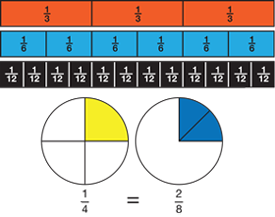Students estimate fraction sums and differences. They use fraction circle pieces, number lines, and multiplication and division strategies to find equivalent fractions with common denominators. Students then use these strategies to solve addition and subtraction problems involving fractions with unlike denominators.
Content in this Lesson
- Estimating sums and differences of fractions using benchmarks and mental math strategies [E9].
- Identifying and finding equivalent fractions using fraction circle pieces, number lines, and multiplication and division strategies [E1].
- Finding common factors and common denominators and using them to add and subtract fractions [E10].
- Adding and subtracting fractions including those with unlike denominators using area models and paper-and-pencil methods [E8].
- Representing addition and subtraction of fractions with fraction circle pieces, number lines, and number sentences [E3].
Daily Practice and Problems A–D
Assessment in this Lesson
| Assessment | Expectation Assessed | Math Practices Expectation Assessed |
|---|---|---|
|
Use Equivalent Fractions to Add and Subtract |
|
|
|
Fraction Sums and Differences |
|
|














 and
and  since 15 is divisible by both 3 and 5.
since 15 is divisible by both 3 and 5.  and
and  .
. ,
, ,
, are equivalent to each other, and
are equivalent to each other, and  and
and  are equivalent to each other.
are equivalent to each other.
 and
and 